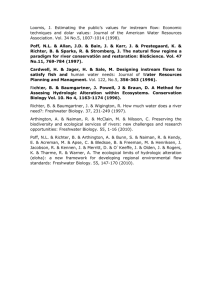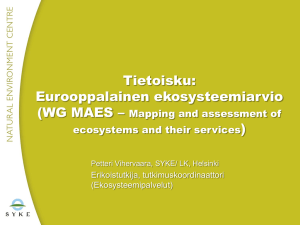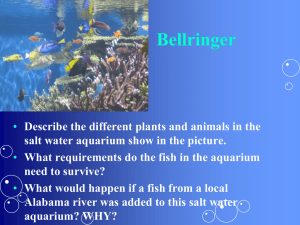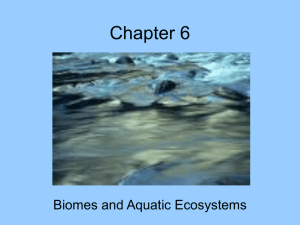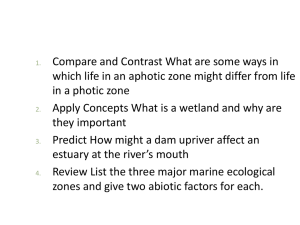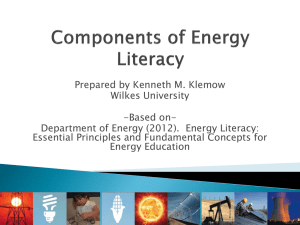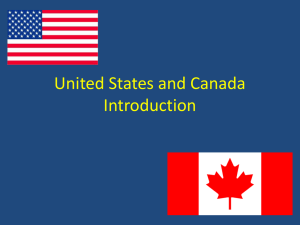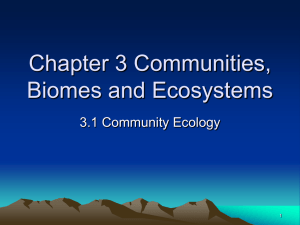BISC 677 - Biology
advertisement
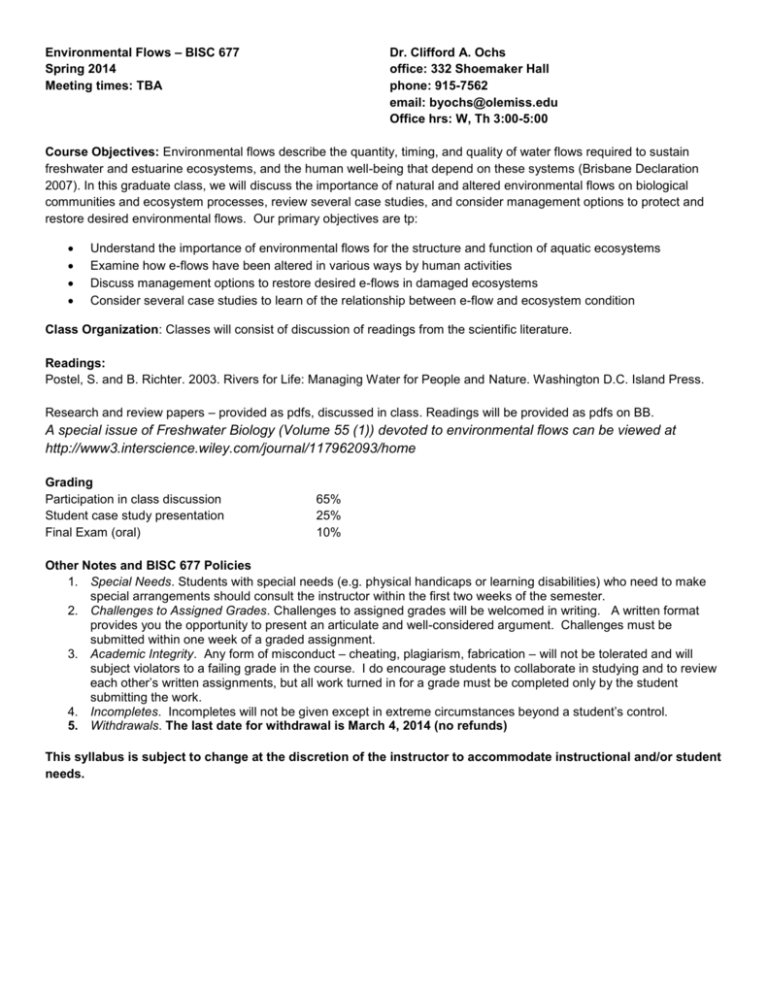
Environmental Flows – BISC 677 Spring 2014 Meeting times: TBA Dr. Clifford A. Ochs office: 332 Shoemaker Hall phone: 915-7562 email: byochs@olemiss.edu Office hrs: W, Th 3:00-5:00 Course Objectives: Environmental flows describe the quantity, timing, and quality of water flows required to sustain freshwater and estuarine ecosystems, and the human well-being that depend on these systems (Brisbane Declaration 2007). In this graduate class, we will discuss the importance of natural and altered environmental flows on biological communities and ecosystem processes, review several case studies, and consider management options to protect and restore desired environmental flows. Our primary objectives are tp: Understand the importance of environmental flows for the structure and function of aquatic ecosystems Examine how e-flows have been altered in various ways by human activities Discuss management options to restore desired e-flows in damaged ecosystems Consider several case studies to learn of the relationship between e-flow and ecosystem condition Class Organization: Classes will consist of discussion of readings from the scientific literature. Readings: Postel, S. and B. Richter. 2003. Rivers for Life: Managing Water for People and Nature. Washington D.C. Island Press. Research and review papers – provided as pdfs, discussed in class. Readings will be provided as pdfs on BB. A special issue of Freshwater Biology (Volume 55 (1)) devoted to environmental flows can be viewed at http://www3.interscience.wiley.com/journal/117962093/home Grading Participation in class discussion Student case study presentation Final Exam (oral) 65% 25% 10% Other Notes and BISC 677 Policies 1. Special Needs. Students with special needs (e.g. physical handicaps or learning disabilities) who need to make special arrangements should consult the instructor within the first two weeks of the semester. 2. Challenges to Assigned Grades. Challenges to assigned grades will be welcomed in writing. A written format provides you the opportunity to present an articulate and well-considered argument. Challenges must be submitted within one week of a graded assignment. 3. Academic Integrity. Any form of misconduct – cheating, plagiarism, fabrication – will not be tolerated and will subject violators to a failing grade in the course. I do encourage students to collaborate in studying and to review each other’s written assignments, but all work turned in for a grade must be completed only by the student submitting the work. 4. Incompletes. Incompletes will not be given except in extreme circumstances beyond a student’s control. 5. Withdrawals. The last date for withdrawal is March 4, 2014 (no refunds) This syllabus is subject to change at the discretion of the instructor to accommodate instructional and/or student needs. The Brisbane Declaration (2007) Environmental Flows are Essential for Freshwater Ecosystem Health and Human Well-Being This declaration presents summary findings and a global action agenda that address the th urgent need to protect rivers globally, as proclaimed at the 10 International River symposium and International Environmental Flows Conference, held in Brisbane, Australia, on 3-6 September 2007. The conference was attended by more than 750 scientists, economists, engineers, resource managers and policy makers from more than 50 countries. Key findings include: Freshwater ecosystems are the foundation of our social, cultural, and economic well-being. Healthy freshwater ecosystems – rivers, lakes, floodplains, wetlands, and estuaries – provide clean water, food, fiber, energy and many other benefits that support economies and livelihoods around the world. They are essential to human health and well-being. Freshwater ecosystems are seriously impaired and continue to degrade at alarming rates. Aquatic species are declining more rapidly than terrestrial and marine species. As freshwater ecosystems degrade, human communities lose important social, cultural, and economic benefits; estuaries lose productivity; invasive plants and animals flourish; and the natural resilience of rivers, lakes, wetlands, and estuaries weakens. The severe cumulative impact is global in scope. Water flowing to the sea is not wasted. Fresh water that flows into the ocean nourishes estuaries, which provide abundant food supplies, buffer infrastructure against storms and tidal surges, and dilute and evacuate pollutants. Flow alteration imperils freshwater and estuarine ecosystems. These ecosystems have evolved with, and depend upon, naturally variable flows of high-quality fresh water. Greater attention to environmental flow needs must be exercised when attempting to manage floods; supply water to cities, farms, and industries; generate power; and facilitate navigation, recreation, and drainage. Environmental flow management provides the water flows needed to sustain freshwater and estuarine ecosystems in coexistence with agriculture, industry, and cities. The goal of environmental flow management is to restore and maintain the socially valued benefits of healthy, resilient freshwater ecosystems through participatory decision making informed by sound science. Ground-water and floodplain management are integral to environmental flow management. Climate change intensifies the urgency. Sound environmental flow management hedges against potentially serious and irreversible damage to freshwater ecosystems from climate change impacts by maintaining and enhancing ecosystem resiliency. Progress has been made, but much more attention is needed. Several governments have instituted innovative water policies that explicitly recognize environmental flow needs. Environmental flow needs are increasingly being considered in water infrastructure development and are being maintained or restored through releases of water from dams, limitations on ground-water and surface-water diversions, and management of land-use practices. Even so, the progress made to date falls far short of the global effort needed to sustain healthy freshwater ecosystems and the economies, livelihoods, and human well-being that depend upon them. Environmental Flows - READINGS BISC 677 (Special Topics) Spring 2014 WEEK 1 – Introduction, History of research on environmental flows 1. Poff and Matthews 2013. Environmental flows in the Anthropocene: past progress and future prospects. Current Opinion in Environmental Sustainability 5: 667-675. 2. The Brisbane Declaration (http://www.watercentre.org/news/declaration) Environmental flows are defined by the Brisbane Declaration as the quantity, timing, and quality of water flows required to sustain freshwater and estuarine ecosystems and the human livelihoods and well-being that depend on these ecosystems. WEEK 2 – The Natural Flow Regime and Normative Flow Regime 1. Poff NL, Allan JD, Bain MB, Karr JR, Prestegaard KL, Richter BD, Sparks RE, Stromberg JC: The natural flow regime. Bioscience 1997, 47:769-784. Bunn SE, Arthington AH: Basic principles and ecological consequences of altered flow regimes for aquatic biodiversity. Environ Manage 2002, 30:492-507. Foundational publication providing a synthetic view of how hydrologic variability structures ecological processes and communities in rivers across hydro-climatic regions, and how alteration of historical flow regimes alters ecological pattern and process. 2. Stanford JA, Ward JV, Liss WJ, Frissell CA, Williams RN, Lichatowich JA, Coutant CC: A general protocol for restoration of regulated rivers. Regul Rivers-Res Manage 1996, 12:391-413. WEEK 3 – Basic principles of hydrology and geomorphology 1. Allan and Castillo 2007. Stream Ecology, Chapters 2-3 (pages 13-56) 2. Arthington, A.H. 2012. Environmental Flows, Saving Rivers in the Third Millennium, Chapters 2-3 (pages 13-48). 3. Bunn SE, Arthington, AH: Basic principles and ecological consequences of altered flow regimes for aquatic biodiversity. Environ Management 2002, 30:492-507. Synthetic paper that articulates the basic principles of flow regime alteration for aquatic and riparian ecosystems. WEEKS 4-5 – Overview of river management issues Postel S, Richter B: Rivers for Life: Managing Water for People and Nature. Washington, DC: Island Press; 2003. WEEK 6 – Identifying Flow-Ecology Relationships 1. Richter BD, Baumgartner JV, Powell J, Braun DP: A method for assessing hydrologic alteration within ecosystems. Conserv Biol 1996, 10:1163-1174. A systematic development of hydrologic metrics that can be used to assess the type and extent of hydrologic alteration to rivers by dams and other human interventions in the flow regime. 2. Flow–ecology relationships: closing the loop on effective environmental flows Peter M. Davies A D , Robert J. Naiman A B , Danielle M. Warfe A , Neil E. Pettit A , Angela H. Arthington C and Stuart E. Bunn C Marine and Freshwater Research - http://dx.doi.org/10.1071/MF13110 WEEK 7 – Quantitative assessment of ecological impairment 1. Poff, N.L. and J.V. Ward. 1989. Implications of streamflow variability and predictability for lotic community structure: a regional analysis of streamflow patterns. Can. J. Fish. Aquat. Sci. 46: 1805-1818. 2. Arthington AH, Bunn SE, Poff NL, Naiman RJ: The challenge of providing environmental flow rules to sustain river ecosystems. Ecol Appl 2006, 16:1311-1318. Proposed new quantitative approach to assessing ecological impairment in flow-altered rivers that lack detailed empirical information. It incorporates essential aspects of natural flow variability shared across particular classes of rivers that can be validated with empirical biological data and other information in a calibration process. WEEK 8 – Dam Nation 1. Dam nation: a geographic census of American dams and their large-scale hydrologic impacts. Water Resources Research 35: 1305-1311. 2. Poff NL, Olden JD, Merritt DM, Pepin DM: Homogenization of regional river dynamics by dams and global biodiversity implications. Proc Natl Acad Sci USA 2007, 104:5732-5737. Paper demonstrating regional-scale impacts of dams on hydrologic variation and implications for maintenance of biodiversity. 3. Ziv G, Baran E, Nam S, Rodriguez-Iturbe I, Levin SA: Trading-off fish biodiversity, food security, and hydropower in the Mekong River Basin. Proc Natl Acad Sci U S A 2012, 109:5609-5614. Important paper that evaluates economic tradeoffs between spatially explicit dam placement and fisheries production in the Mekong River system. WEEK 9 – ELOHA 1. Poff, N. L., Richter, B. D., Arthington, A. H., Bunn, S. E., Naiman, R. J., Kendy, E., Acreman, M., Apse, C., Bledsoe, B. P., Freeman, M. C., Henriksen, J., Jacobson, R. B., Kennen, J. G., Merritt, D. M., O'Keeffe, J. H., Olden, J. D., Rogers, K., Tharme, R. E., and Warner, A. 2010. The ecological limits of hydrologic alteration (ELOHA): a new framework for developing regional environmental flow standards. Freshwater Biology 55:147-170. Framework to assess the implications of flow alterations on riverine ecosystems in a more systematic way by using a classification scheme to assign rivers to different types. Practical stepwise guidance for a scientifically based implementation of environmental flow requirements, including incorporation of societal preferences. 2. Arthington AH, Naiman RJ, McClain ME, Nilsson C: Preserving the biodiversity and ecological services of rivers: new challenges and research opportunities. Freshw Biol 2010, 55:1-16. Comprehensive summary of major insights and recommendations derived from a special issue in Freshwater Biology on environmental flows — ecological data, new methods and analytical framework (ELOHA), along with individual case studies. WEEK 10 – Climate Change and Water Security 1. Doll P, Zhang J: Impact of climate change on freshwater ecosystems: a global-scale analysis of ecologically relevant river flow alterations. Hydrol Earth Syst Sci 2010, 14:783-799. First systematic attempt to quantify sensitivity of natural flow regime components to climate change on a global scale. 2. Matthews JH, Wickel BAJ, Freeman S: Converging currents in climate-relevant conservation: Water, infrastructure, and institutions. PLoS Biol 2011, 9. One of the first papers to address the role of conservation science providing the practical decision making tools for funding, designing, and operating water infrastructure to enable both economic and ecological sustainability in the context of climate change adaptation. 3. Vorosmarty CJ, McIntyre PB, Gessner MO, Dudgeon D, Prusevich A, Green P, Glidden S, Bunn SE, Sullivan CA, Liermann CR et al.: Global threats to human water security and river biodiversity. Nature 2010, 467:555-561. Diagnostic analysis of implications of threats to water security. Analyses provided evidence that increasing water security for humans is achieved to the expense of water security for the environment. WEEK 11 – Integrated water resources management (IWRM) 1. Naiman, R. J., Bunn, S. E., Nilsson, C., Petts, G. E., Pinay, G., and Thompson, L. C. 2002. Legitimizing fluvial ecosystems as users of water: An overview. Environ. Manage. (N.Y.), 30, 455–467. 2. Bernhardt, E., et al. 2006. “Perspective: The challenge of ecologically sustainable water management.” Water Policy, 8, 475–479. 3. Poff NL: Managing for variability to sustain freshwater ecosystems. J Water Resour Planning Manage-ASCE 2009, 135:1-4. A brief editorial on the importance of the need to design for natural flow variability and regional connectivity in water resources development to achieve freshwater sustainability. WEEK 12 – Current state of environmental flows science and practice 1. Pahl-Wostl, C, Arthington, AH, Bogardi J, Bunn SE, Hoff H, Lebel L, Nikitina E, Palmer MA, Poff NL, Richards K et al.: Environmental flows and water governance: managing sustainable water uses. Curr Opin Environ Sustain 2013 http://dx.doi.org/10.1016/ j.cosust.2013.06.009. Paper that builds on recent advances in environmental flow science (ELOHA), water governance and management, to construct a framework that more systematically determines environmental flow requirements analysis on both the natural and social science fronts, and in particular, on the interaction between social/political and environmental systems. 2. Acreman M, Overton I, King J, Wood P, Dunbar M, Kendy E, Young W: The changing role of eco-hydrological science in guiding environmental flows. Hydrol Sci J 2013. Insightful perspective on the current state of environmental flows science and practice, with treatment of setting objectives, scientific approaches and uncertainty, implementation challenges, and the need for better communication by scientists with policy makers and managers. WEEKS 13 – 14 Student Case Study presentations http://en.wikipedia.org/wiki/File:Earth%27s_water_distribution.svg Only 0.009% (< 1 part/10,000 parts) of all water on Earth is in fresh surface water.
